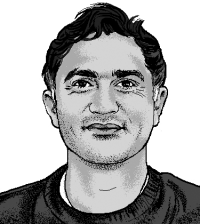April 19, Easter 3B (Luke 24:36b-48)
Touch me and see, said the prisoners. Shake my hand and discover that I am human like you.
“Touch me and see.” I whispered these words of Jesus to myself as I stood with hundreds of others, face to face with a human wall of police in riot gear. We were gathered in downtown Durham the night after the news that the New York City police officer who choked Eric Garner to death would not go to trial. A throng of protesters blocked streets, chanting “I can’t breathe” and “Hands up, don’t shoot” and “Shut it down.”
Touch and see. The police blocked us from seeing them, from seeing their skin, their bodies, their personhood. Helmets covered their heads and plastic shields veiled their faces, distorting their countenance. From their necks down to their combat boots, they wore black uniforms—padded with armor, reinforced plastic and rubber running up their legs and down their arms. Their gloved hands held metal clubs, warning us to stay away. They would not be touched or seen.
Read our latest issue or browse back issues.
But the police touched people. I saw one officer plunge into the crowd to pull out a black woman, throwing her to the ground face first and thrusting his knee into her back as he yanked her arms behind her and bound her hands with a cable tie. The officer touched whomever he pleased, and with violent force—yet he and his colleagues made it clear that they would not be touched by us. Human touch happened only on their terms, and when it did happen, it was not humane. Like the officer who put his arm around Garner’s neck, these officers did not seem to know how to touch others without violence.
Once, in a class I taught in a prison, the incarcerated men started talking about which officers and staff would and wouldn’t shake their hands. To shake hands was a sign of respect, of mutuality, of recognition that they shared at least one thing in common: their human flesh. The men all agreed that they were grateful for the new chaplain who had started that week, because he looked them in the eyes and shook their hands. I could imagine them saying the words of Jesus, “Touch me and see.” Shake my hand and discover that I am human like you.
After the resurrection, the disciples don’t recognize that Jesus is fully human, as human as they are. “They were startled and terrified,” says Luke, “and thought that they were seeing a ghost.” They see him, but they don’t see him. They recognize him as Jesus but are convinced that he is not the human Jesus, not Jesus fully alive, not flesh and blood like their own flesh and blood. For the disciples, Jesus is at first a ghost, an unclean spirit from the grave—Jesus undead in their midst. He is other and strange, provoking fear in the people in the room.
“The only way I can describe it, it looks like a demon.” That’s what Ferguson, Missouri, police officer Darren Wilson said about Michael Brown. “It” looked like a demon, a ghastly figure. So, Wilson testified, “I shoot a series of shots. I don’t know how many I shot, I just know I shot it.” Again, “it”—an impersonal pronoun for a nonperson, a being too different to have the same kind of flesh as Wilson’s. When Wilson saw Brown, he saw a fundamental difference between their existences. The implication is of blackness as a racial marker of an ontological chasm separating two individuals, blackness as demonic menace—an “it” and not a “he.”
The disciples, “startled and terrified,” experience Jesus as terror, as threat. Jesus tries to soothe their panic with words of reassurance: “Peace be with you.” I imagine him with his hands up, showing that he’s weaponless. I picture him with arms outstretched toward his friends, reaching out to shake their hands, to exchange a touch—a mutual recognition of their shared humanity. “Look at my hands and my feet,” he says, “see that it is I myself.” He’s emphatic, emphatically alive, and desperate for them to see him—to recognize him and to know that he is human, not a ghost or a demon or an “it.”
The gospel of Christ’s peace happens in our touch, in which gentleness is made flesh. “Why not simply try to touch the other,” writes Franz Fanon, “discover each other?” To trust in the resurrection of Jesus is to believe in the transfiguration of all flesh, to believe that God comes to us in our encounter with the other.
I want a world transfigured with Christ’s peace, with resurrection pulsing through our bodies. The touch of Christ disarming Officer Wilson. Christ’s hands in Michael Brown’s hands. Christ’s touch, full of grace and mercy—not the threat of a police baton, not the violence of a choke hold, not an abusive or deathly touch, but the life-giving and life-affirming hands of Jesus, gentleness made flesh in all of us. We must look forward, as Dom Sebastian Moore puts it, “to the point when the whole mystery of God will be known in the clasp of your brother’s [or sister’s] hand.”
“Touch me and see.” “Don’t shoot.” See my body; see my life. It’s like yours, human flesh. Jesus invites his friends to see him as a stranger who is a friend, an other who is the same—to recognize Jesus’ flesh in others and to discover that our neighbor’s hand offers us the fellowship of Christ.








